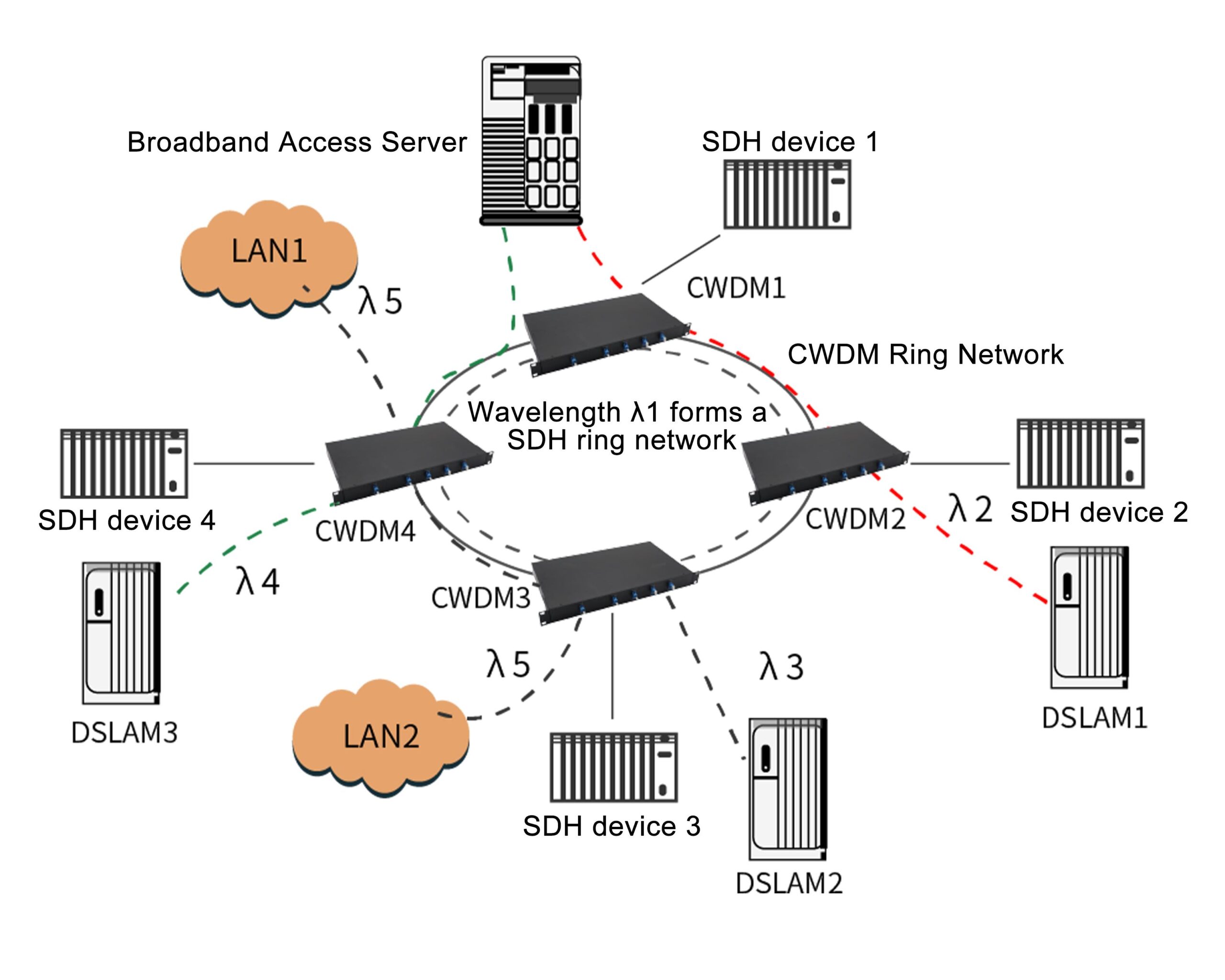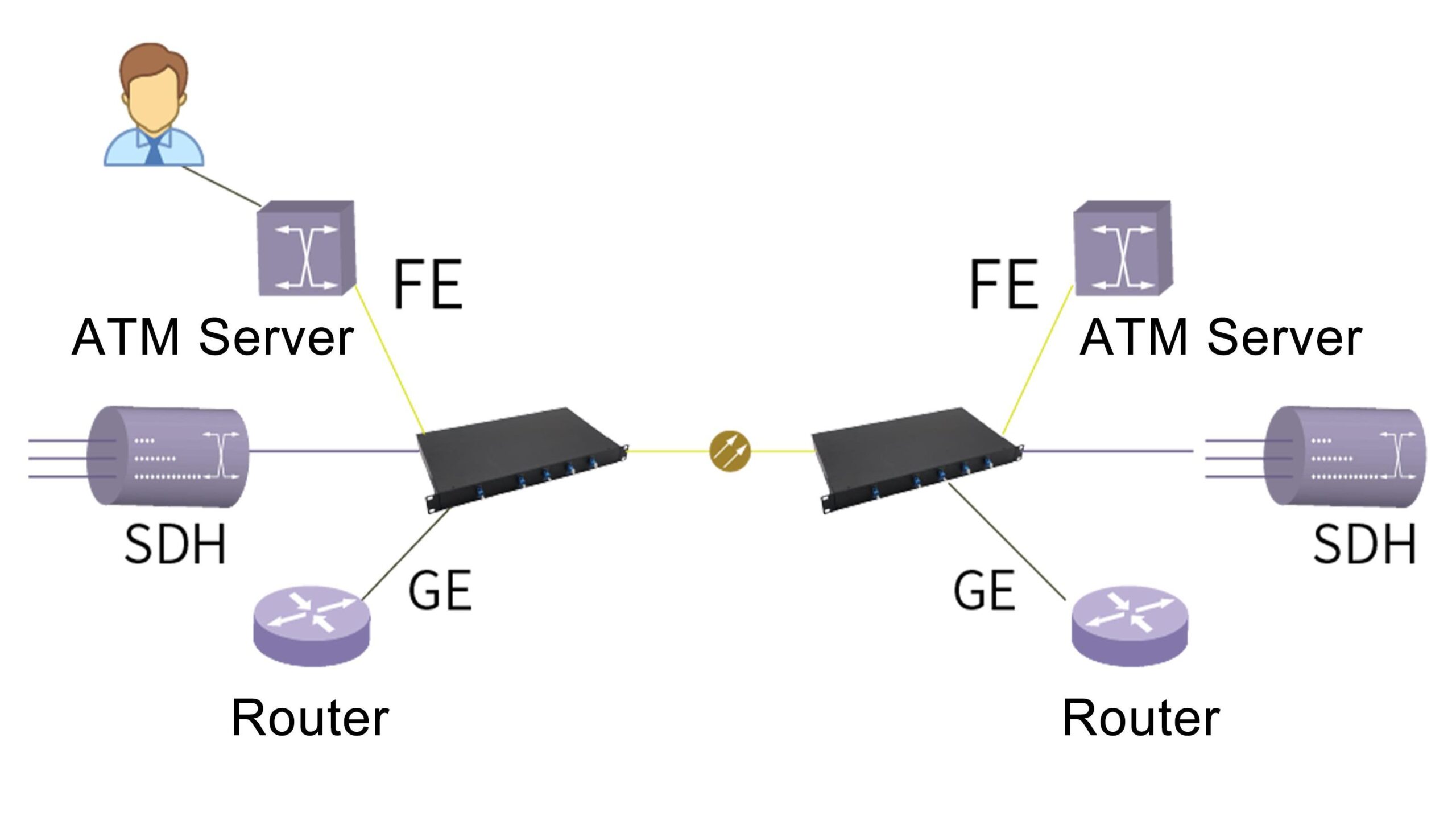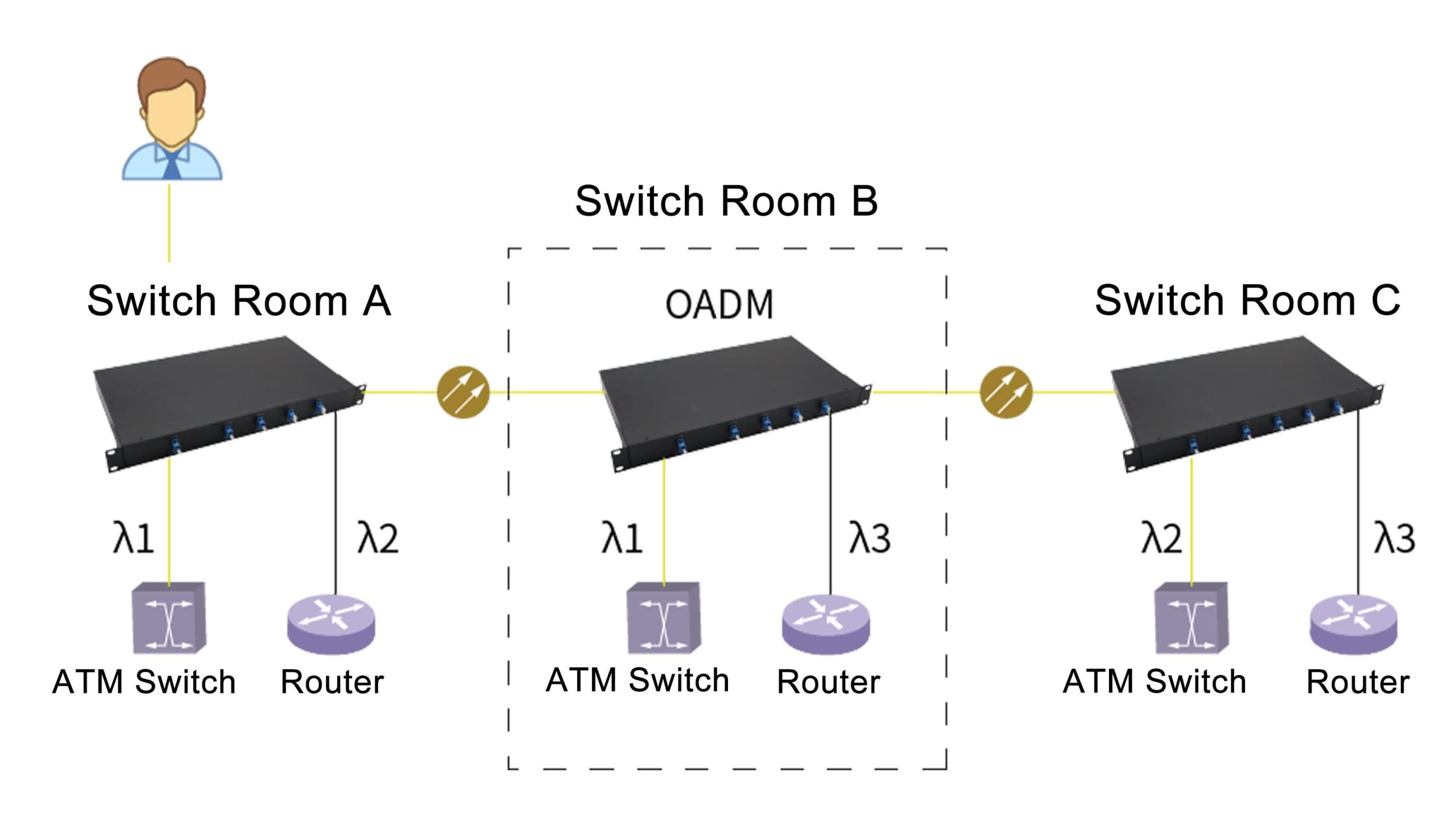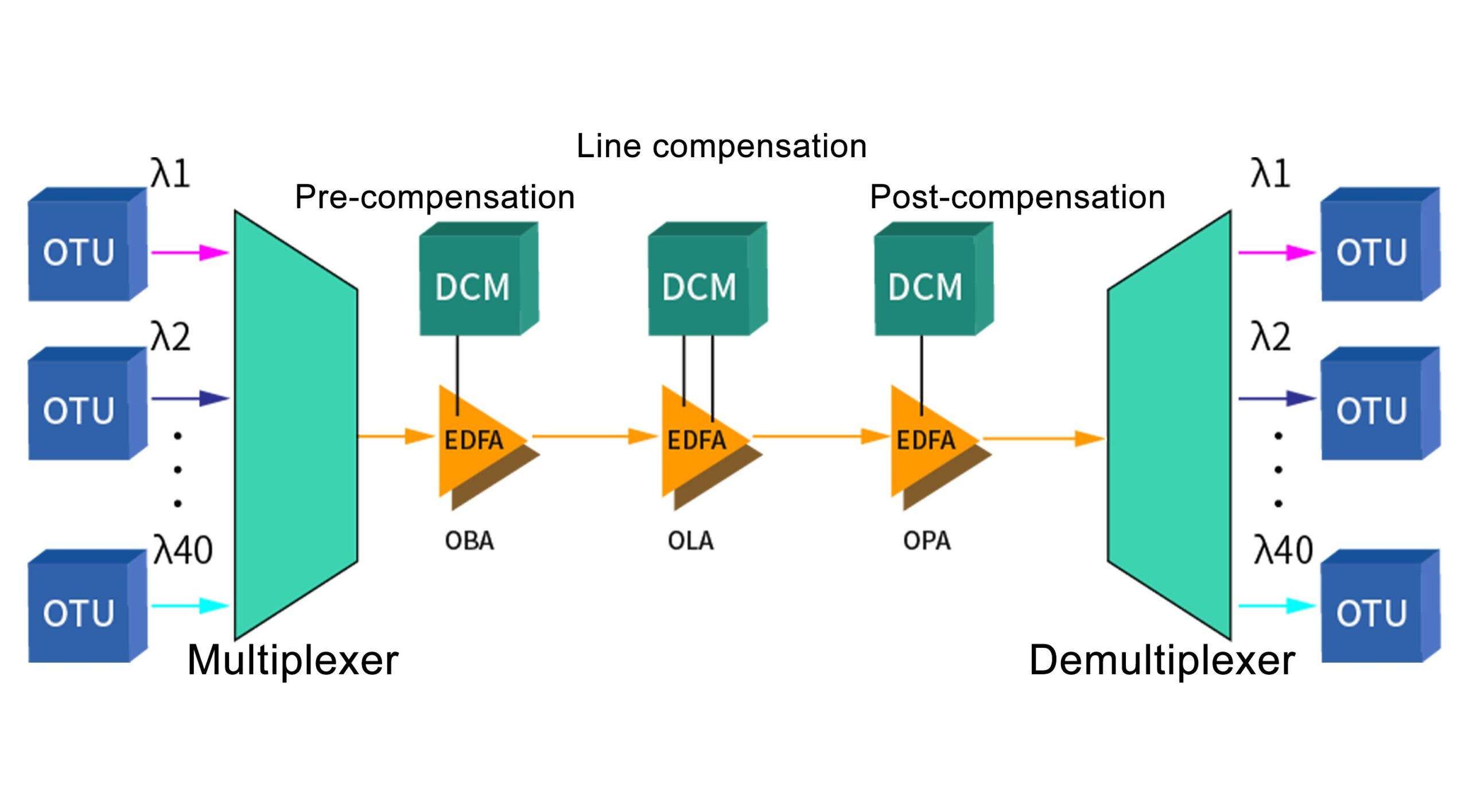Wavelength Division Multiplexing (WDM) including Coarse Wavelength Division Multiplexing (CWDM) and Dense Wavelength Division Multiplexing (DWDM). It refers to the simultaneous transmission of multiple signals with different wavelengths on a single optical fiber. The primary purpose of WDM is to increase the available bandwidth of the optical fiber, allowing for capacity expansion without the need to lay additional fiber cables. Therefore, it is widely adopted by telecommunication companies.
CWDM: Wavelength spacing ≥ 20nm, typically using eight wavelength bands between 1470 and 1610nm with 20nm spacing.
DWDM: Wavelength spacing < 10nm, typically using the wavelength range of 1550-1570nm with wavelength spacings of 200GHz (1.6nm), 100GHz (0.8nm), 0r 50GHz (0.4nm).


In general, for CWDM, uncooled laser diodes are used, while for DWDM, cooled laser diodes are employed. Cooled laser diodes use temperature tuning, while uncooled laser diodes use electronic tuning.
Due to the high level of integration of Dense Wavelength Division Multiplexing (DWDM) equipment, DWDM devices can transmit over longer distances compared to CWDM devices.
CWDM Wavelength Division Multiplexing devices currently cannot achieve unlimited-distance transmission, with their maximum transmission distance being limited to 160 kilometers, whereas DWDM devices can achieve significantly greater transmission distances than CWDM devices.
The DWDM Wavelength Division Multiplexing system, due to the uneven temperature distribution across a wide wavelength range, increase the operational cost when employing laser cooling technology to regulate temperature.
Furthermore, DWDM Wavelength Division Multiplexing systems typically cost four to five times more than CWDM Wavelength Division Multiplexing systems. However, as DWDM becomes more widespread, the prices of DWDM optical modules are now nearly 20%-25% lower than CWDM optical modules.
Compared to DWDM, the primary advantages of CWDM systems lies in their lower cost, with the main cost components being filters and lasers. The wider 20nm wavelength spacing of CWDM requires less stringent technical specifications for lasers and simplifies the structure of optical multiplexers/ demultiplexers, increasing production yield and reducing costs.
DWDM, on the other hand, is suitable for long-distance transmission. With its tighter wavelength spacing, DWDM can accommodate 8 to 160 wavelengths on a single optical fiber, making it more suitable for long-distance transmission. With the assistance of Erbium-Doped Fiber Amplifiers (EDFAs), DWDM systems can operate over ranges of thousands of kilometers.
CWDM and DWDM have different application scenarios due to their distinct characteristics.
CWDM is used for metropolitan area network access, telecommunications, enterprise networks, campus networks, and other shorter-distance communication scenarios. It provides basic optical fiber network transmission and can meet general communication needs.
DWDM is suitable for long-distance transmission, high-capacity long-haul networks, or ultra-high-capacity core nodes in metropolitan area networks.
Due to the increasing demand for bandwidth, DWDM has made significant strides in cost reduction, making it increasing popular in the market. However, CWDM still maintains a price advantage, particularly in scenarios with connection rates below 10G and short-distance transmission. In low data network deployments, CWDM remains the most feasible option available.
CWDM equipment and DWDM equipment each have their own advantages in OTN networks. CWDM equipment’s advantage lies in its ability to utilize cost-effective uncooled distributed feedback lasers and inexpensive passive filters. This makes it currently widely adopted in systems where cost is a key consideration compared to DWDM equipment.
While adopting CWDM technology in DWDM systems allows for the use of more cost-effective optical modules, the larger channel spacing of CWDM results in a reduced number of available wavelengths in the system. This limitation restricts the system’s transmission capacity to some extent, making it not quite on par with non-hybrid DWDM equipment.

Based on the analysis provided above, it is clear that in the future, CWDM and DWDM equipment will complement each other rather than replace each other.




Implementing DWDM point-to-point transmission
In a point-to-point topology, devices utilize limited optical fiber resources to multiplex and aggregate multiple services bidirectionally between two points, achieving several times the original bandwidth capacity, surpassing CWDM in terms of bandwidth capacity.

Implementing OADM ring network
By using wavelength division multiplexing terminal equipment (Mux/Demux) in conjunction with optical add-drop multiplexing devices (OADM), multiple wavelengths are utilized in an up-and-downstream fashion to establish a ring topology network in metropolitan optical communications.

Using multiple wavelength channels in a dual-fiber setup to establish symmetrical ring network for services. In the event of a main route failure, services are automatically switched to the backup route, ensuring protection at both the service and multiplexing segment levels. This ensures stable service transmission and enhances system reliability.
Additionally, DWDM channels are independent of one another, enabling interference-free communication and increasing capacity while conserving optical fiber resources. This approach ensures the security and stability of service signals, highlighting the advantages of wavelength division multiplexing.

Utilizing Erbium-Doped Fiber Amplifier(EDFA) optical amplification technology in conjunction with DWDM to enable long-distance transmission. Additionally, considering the issue of dispersion and implementing dispersion compensation.

Originally, due to the requirement of four optical fibers connecting each node to the core layer switch, a significant amount of optical fiber resources were needed. With the dual-star network using DWDM components, the same functionality can be achieved with very few optical fibers. This approach also allows for more user access on limited optical fiber resources.
So far, if users need more channels in their WDM network, they have had to transition to using DWDM equipment. DWDM equipment allows for a significant increase in the number of channels due to its smaller wavelength spacing. But it also significantly increases the cost per channel. Therefore, users need to assess their future business growth and determine whether to install less flexible CWDM equipment at a lower initial cost or opt for more flexible DWDM equipment at a higher initial cost.